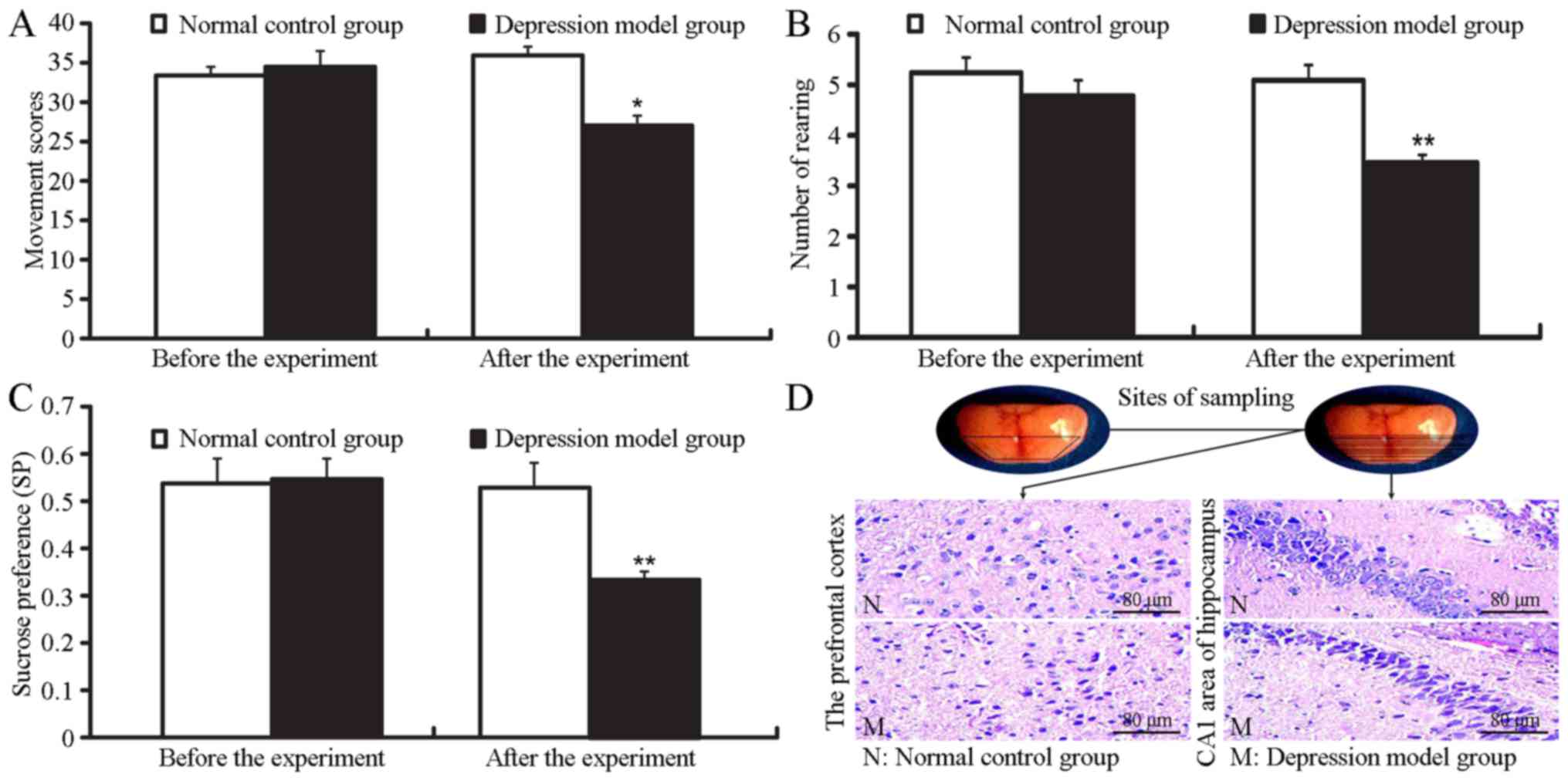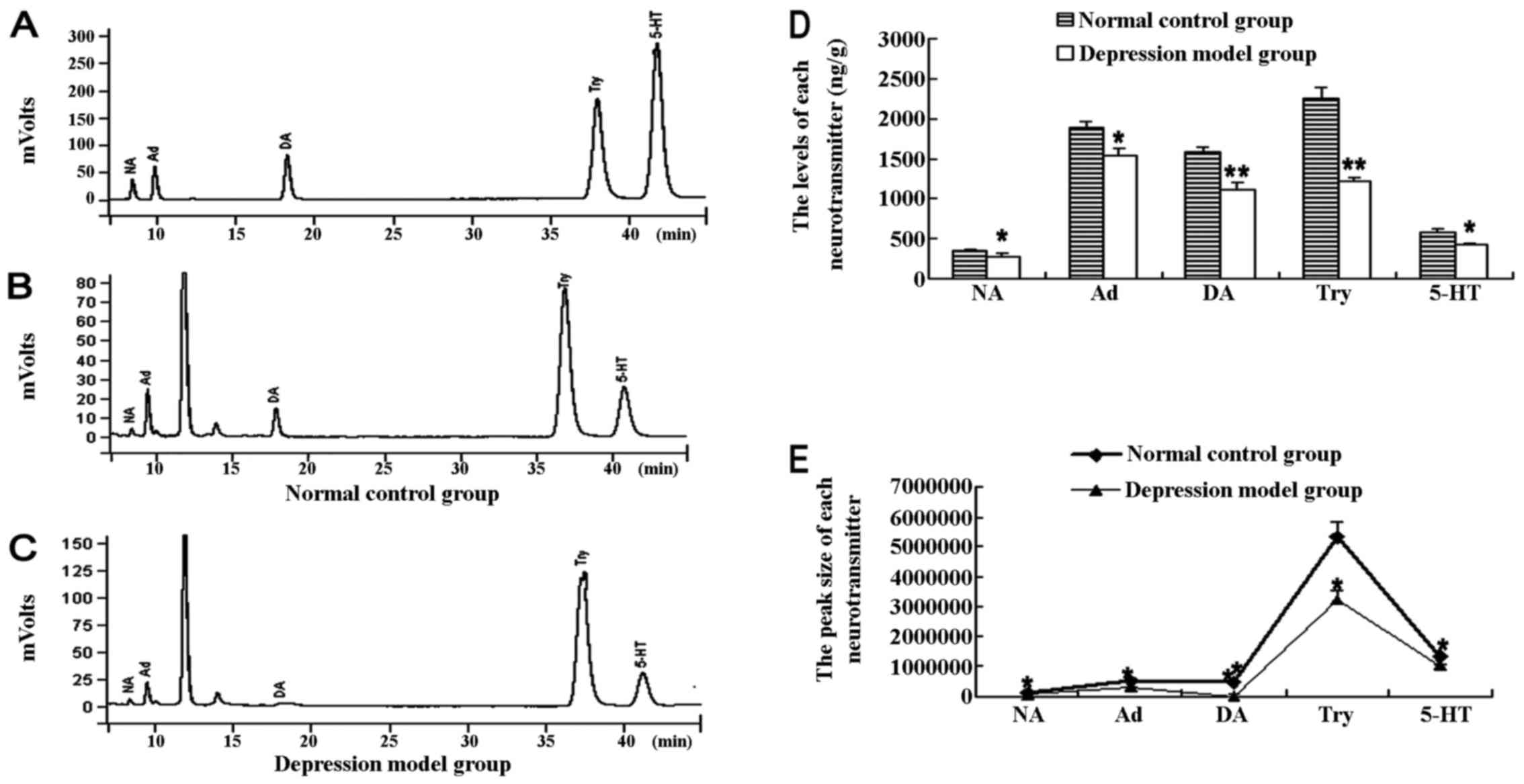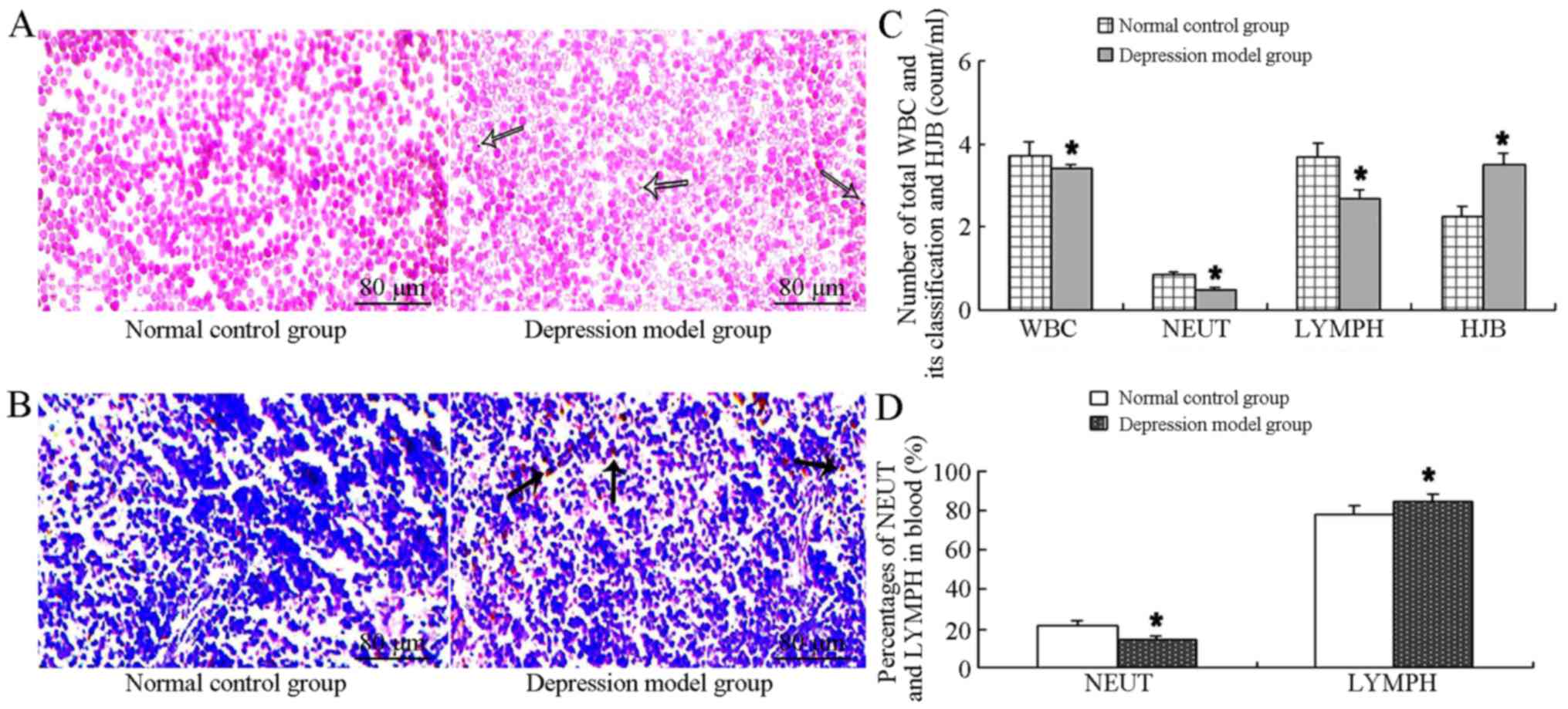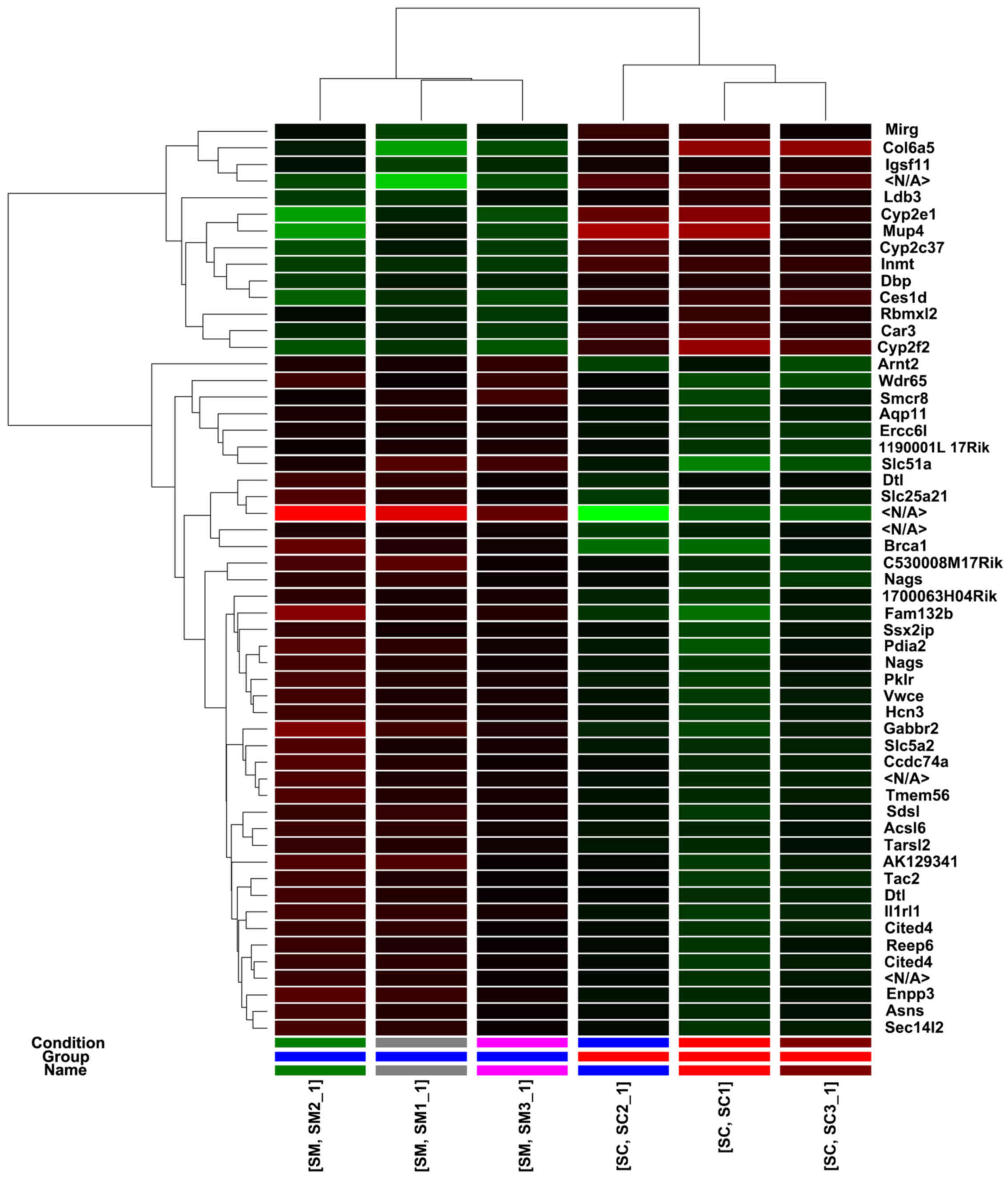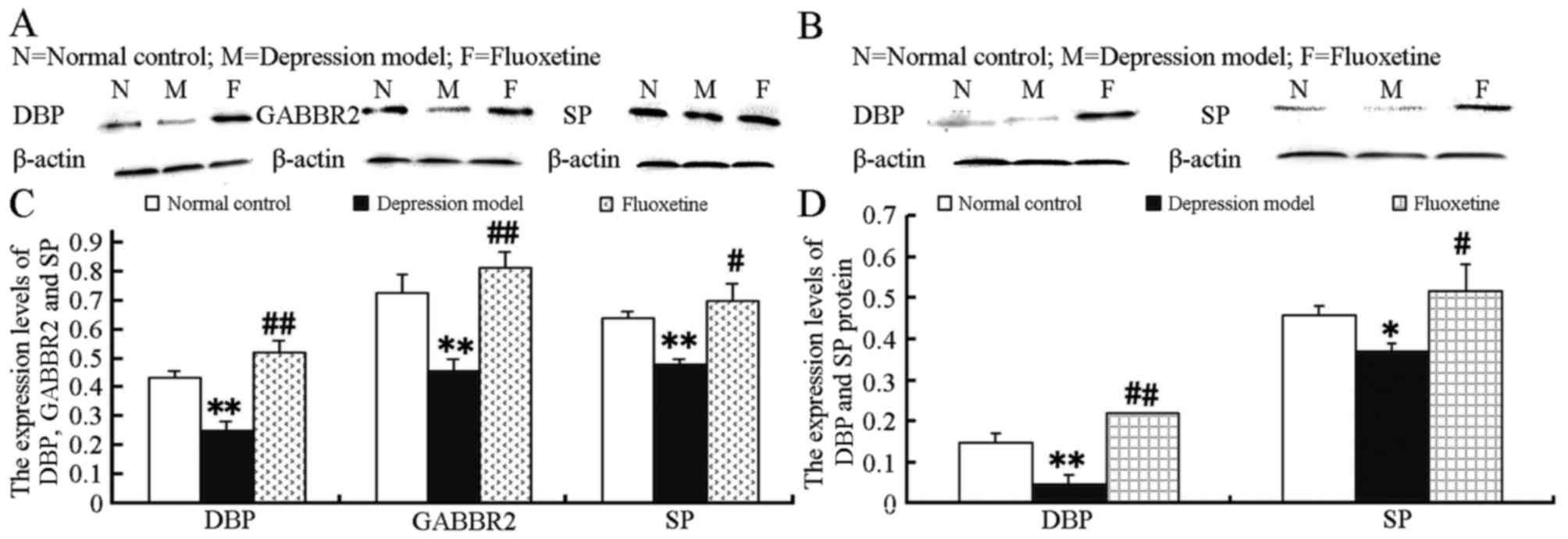|
1
|
Lépine JP and Briley M: The increasing
burden of depression. Neuropsychiatr Dis Treat. 7(Suppl 1): 3–7.
2011.PubMed/NCBI
|
|
2
|
Arroll B, Macgillivray S, Ogston S, Reid
I, Sullivan F, Williams B and Crombie I: Efficacy and tolerability
of tricyclic antidepressants and SSRIs compared with placebo for
treatment of depression in primary care: A meta-analysis. Ann Fam
Med. 3:449–456. 2005. View
Article : Google Scholar : PubMed/NCBI
|
|
3
|
Kok RM, Heeren TJ and Nolen WA: Continuing
treatment of depression in the elderly: A systematic review and
meta-analysis of double-blinded randomized controlled trials with
antidepressants. Am J Geriatr Psychiatry. 19:249–255. 2011.
View Article : Google Scholar : PubMed/NCBI
|
|
4
|
McIntyre RS: When should you move beyond
first-line therapy for depression? J Clin Psychiatry. 71(Suppl 1):
16–20. 2010. View Article : Google Scholar : PubMed/NCBI
|
|
5
|
Shrestha P, Mousa A and Heintz N: Layer
2/3 pyramidal cells in the medial prefrontal cortex moderate stress
induced depressive behaviors. Elife. 4:e087522015. View Article : Google Scholar :
|
|
6
|
Papadopoulou A, Siamatras T,
Delgado-Morales R, Amin ND, Shukla V, Zheng YL, Pant HC, Almeida OF
and Kino T: Acute and chronic stress differentially regulate
cyclin-dependent kinase 5 in mouse brain: Implications to
glucocorticoid actions and major depression. Transl Psychiatry.
5:e5782015. View Article : Google Scholar : PubMed/NCBI
|
|
7
|
Blume J, Douglas SD and Evans DL: Immune
suppression and immune activation in depression. Brain Behav Immun.
25:221–229. 2011. View Article : Google Scholar :
|
|
8
|
Kiank C, Zeden JP, Drude S, Domanska G,
Fusch G, Otten W and Schuett C: Psychological stress-induced,
IDO1-dependent tryptophan catabolism: Implications on
immunosuppression in mice and humans. PLoS One. 5:e118252010.
View Article : Google Scholar : PubMed/NCBI
|
|
9
|
Hernandez ME, Martinez-Mota L, Salinas C,
Marquez-Velasco R, Hernandez-Chan NG, Morales-Montor J, Pérez-Tapia
M, Streber ML, Granados-Camacho I, Becerril E, et al: Chronic
stress induces structural alterations in splenic lymphoid tissue
that are associated with changes in corticosterone levels in
wistar-kyoto rats. BioMed Res Int. 2013:8687422013. View Article : Google Scholar : PubMed/NCBI
|
|
10
|
Park AJ, Collins J, Blennerhassett PA,
Ghia JE, Verdu EF, Bercik P and Collins SM: Altered colonic
function and microbiota profile in a mouse model of chronic
depression. Neurogastroenterol Motil. 25:733–e575. 2013. View Article : Google Scholar : PubMed/NCBI
|
|
11
|
Voorhees JL, Tarr AJ, Wohleb ES, Godbout
JP, Mo X, Sheridan JF, Eubank TD and Marsh CB: Prolonged restraint
stress increases IL-6, reduces IL-10, and causes persistent
depressive-like behavior that is reversed by recombinant IL-10.
PLoS One. 8:e584882013. View Article : Google Scholar : PubMed/NCBI
|
|
12
|
Ago Y, Yano K, Araki R, Hiramatsu N, Kita
Y, Kawasaki T, Onoe H, Chaki S, Nakazato A, Hashimoto H, et al:
Metabotropic glutamate 2/3 receptor antagonists improve behavioral
and prefrontal dopaminergic alterations in the chronic
corticosterone-induced depression model in mice. Neuropharmacology.
65:29–38. 2013. View Article : Google Scholar
|
|
13
|
Zhou Y, Lu L, Li Z, Gao X, Tian J, Zhang
L, Wu B and Qin X: Antidepressant-like effects of the fractions of
Xiaoyaosan on rat model of chronic unpredictable mild stress. J
Ethnopharmacol. 137:236–244. 2011. View Article : Google Scholar : PubMed/NCBI
|
|
14
|
Lee B, Sur B, Yeom M, Shim I, Lee H and
Hahm DH: L-tetrahydropalmatine ameliorates development of anxiety
and depression-related symptoms induced by single prolonged stress
in rats. Biomol Ther (Seoul). 22:213–222. 2014. View Article : Google Scholar
|
|
15
|
Bhatt S, Radhakrishnan M, Jindal A,
Devadoss T and Dhar AK: Neuropharmacological evaluation of a novel
5-HT3 receptor antagonist (6g) on chronic unpredictable mild
stress-induced changes in behavioural and brain oxidative stress
parameters in mice. Indian J Pharmacol. 46:191–196. 2014.
View Article : Google Scholar : PubMed/NCBI
|
|
16
|
Ren J, Fan C, Chen N, Huang J and Yang Q:
Resveratrol pretreatment attenuates cerebral ischemic injury by
upregulating expression of transcription factor Nrf2 and HO-1 in
rats. Neurochem Res. 36:2352–2362. 2011. View Article : Google Scholar : PubMed/NCBI
|
|
17
|
Lv QQ, Wu WJ, Guo XL, Liu RL, Yang YP,
Zhou DS, Zhang JX and Liu JY: Antidepressant activity of astilbin:
Involvement of monoaminergic neurotransmitters and BDNF signal
pathway. Biol Pharm Bull. 37:987–995. 2014. View Article : Google Scholar : PubMed/NCBI
|
|
18
|
Dor FJ, Gollackner B, Kuwaki K, Ko DS,
Cooper DK and Houser SL: Histopathology of spleen allograft
rejection in miniature swine. Int J Exp Pathol. 86:57–66. 2005.
View Article : Google Scholar : PubMed/NCBI
|
|
19
|
Angst F, Stassen HH, Clayton PJ and Angst
J: Mortality of patients with mood disorders: Follow-up over 34–38
years. J Affect Disord. 68:167–181. 2002. View Article : Google Scholar : PubMed/NCBI
|
|
20
|
Jangra A, Lukhi MM, Sulakhiya K, Baruah CC
and Lahkar M: Protective effect of mangiferin against
lipopolysaccharide-induced depressive and anxiety-like behaviour in
mice. Eur J Pharmacol. 740:337–345. 2014. View Article : Google Scholar : PubMed/NCBI
|
|
21
|
Kohan G, Ocampo CG, Zandalazini HI,
Klappenbach R, Quesada BM, Porras LT, Rodriguez JA and Oria AS:
Changes in gastrosplenic circulation and splenic function after
distal pancreatectomy with spleen preservation and splenic vessel
excision. J Gastrointest Surg. 17:1739–1743. 2013. View Article : Google Scholar : PubMed/NCBI
|
|
22
|
Schlitt T, Palin K, Rung J, Dietmann S,
Lappe M, Ukkonen E and Brazma A: From gene networks to gene
function. Genome Res. 13:2568–2576. 2003. View Article : Google Scholar : PubMed/NCBI
|
|
23
|
Lagus M, Gass N, Saharinen J, Savelyev S,
Porkka-Heiskanen T and Paunio T: Inter-tissue networks between the
basal forebrain, hippocampus, and prefrontal cortex in a model for
depression caused by disturbed sleep. J Neurogenet. 26:397–412.
2012. View Article : Google Scholar : PubMed/NCBI
|
|
24
|
Li JZ, Bunney BG, Meng F, Hagenauer MH,
Walsh DM, Vawter MP, Evans SJ, Choudary PV, Cartagena P, Barchas
JD, et al: Circadian patterns of gene expression in the human brain
and disruption in major depressive disorder. Proc Natl Acad Sci
USA. 110:9950–9955. 2013. View Article : Google Scholar : PubMed/NCBI
|
|
25
|
Guan XT, Lin WJ and Tang MM: Comparison of
stress-induced and LPS-induced depressive-like behaviors and the
alterations of central proinflammatory cytokines mRNA in rats.
Psych J. 4:113–122. 2015. View Article : Google Scholar : PubMed/NCBI
|
|
26
|
Kim MH and Leem YH: Chronic exercise
improves repeated restraint stress-induced anxiety and depression
through 5HT1A receptor and cAMP signaling in hippocampus. J Exerc
Nutrition Biochem. 18:97–104. 2014. View Article : Google Scholar
|
|
27
|
Elenkov IJ: Glucocorticoids and the
Th1/Th2 balance. Ann NY Acad Sci. 1024:138–146. 2004. View Article : Google Scholar : PubMed/NCBI
|
|
28
|
Lipson RL, Bayrd ED and Watkins CH: The
postsplenectomy blood picture. Am J Clin Pathol. 32:526–532. 1959.
View Article : Google Scholar : PubMed/NCBI
|
|
29
|
Marques RG, Lucena SB, Caetano CE, de
Sousa VO, Portela MC and Petroianu A: Blood clearance of
Howell-Jolly bodies in an experimental autogenic splenic implant
model. Br J Surg. 101:820–827. 2014. View Article : Google Scholar : PubMed/NCBI
|
|
30
|
Paulo DN, Paulo IC, Kalil M, Vargas PM,
Silva AL, Baptista JF and Guerra AJ: Subtotal splenectomy
preserving the lower pole in rats: Technical, morphological and
functional aspects. Acta Cir Bras. 21:321–327. 2006. View Article : Google Scholar : PubMed/NCBI
|
|
31
|
Jin ZL, Gao N, Li XR, Tang Y, Xiong J,
Chen HX, Xue R and Li YF: The antidepressant-like pharmacological
profile of Yuanzhi-1, a novel serotonin, norepinephrine and
dopamine reuptake inhibitor. Eur Neuropsychopharmacol. 25:544–556.
2015. View Article : Google Scholar : PubMed/NCBI
|
|
32
|
Lima A, Sardinha VM, Oliveira AF, Reis M,
Mota C, Silva MA, Marques F, Cerqueira JJ, Pinto L, Sousa N and
Oliveira JF: Astrocyte pathology in the prefrontal cortex impairs
the cognitive function of rats. Mol Psychiatry. 19:834–841. 2014.
View Article : Google Scholar : PubMed/NCBI
|
|
33
|
Raison CL and Miller AH: The
neuroimmunology of stress and depression. Semin Clin
Neuropsychiatry. 6:277–294. 2001. View Article : Google Scholar : PubMed/NCBI
|
|
34
|
Molteni R, Macchi F and Riva MA: Gene
expression profiling as functional readout of rodent models for
psychiatric disorders. Cell Tissue Res. 354:51–60. 2013. View Article : Google Scholar : PubMed/NCBI
|
|
35
|
Shelton RC, Claiborne J,
Sidoryk-Wegrzynowicz M, Reddy R, Aschner M, Lewis DA and Mirnics K:
Altered expression of genes involved in inflammation and apoptosis
in frontal cortex in major depression. Mol Psychiatry. 16:751–762.
2011. View Article : Google Scholar
|
|
36
|
Fatemi SH, Folsom TD, Rooney RJ and Thuras
PD: Expression of GABAA α2-, β1- and ε-receptors are altered
significantly in the lateral cerebellum of subjects with
schizophrenia, major depression and bipolar disorder. Transl
Psychiatry. 3:e3032013. View Article : Google Scholar
|
|
37
|
Zuo HX, Li JQ, Han B, Ke CJ, Liu XD, Zhang
YC, Li L and Yang X: Di-(n-butyl)-phthalate-induced oxidative
stress and depression-like behavior in mice with or without
ovalbumin immunization. Biomed Environ Sci. 27:268–280.
2014.PubMed/NCBI
|
|
38
|
Le-Niculescu H, McFarland MJ, Ogden CA,
Balaraman Y, Patel S, Tan J, Rodd ZA, Paulus M, Geyer MA, Edenberg
HJ, et al: Phenomic, convergent functional genomic, and biomarker
studies in a stress-reactive genetic animal model of bipolar
disorder and co-morbid alcoholism. Am J Med Genet B Neuropsychiatr
Genet. 147B. pp. 134–166. 2008, View Article : Google Scholar
|
|
39
|
Bettler B, Kaupmann K, Mosbacher J and
Gassmann M: Molecular structure and physiological functions of
GABA(B) receptors. Physiol Rev. 84:835–867. 2004. View Article : Google Scholar : PubMed/NCBI
|
|
40
|
Rimón R, Le Grevés P, Nyberg F, Heikkilä
L, Salmela L and Terenius L: Elevation of substance P-like peptides
in the CSF of psychiatric patients. Biol Psychiatry. 19:509–516.
1984.PubMed/NCBI
|
|
41
|
Bondy B, Baghai TC, Minov C, Schüle C,
Schwarz MJ, Zwanzger P, Rupprecht R and Möller HJ: Substance P
serum levels are increased in major depression: Preliminary
results. Biol Psychiatry. 53:538–542. 2003. View Article : Google Scholar : PubMed/NCBI
|
|
42
|
Cizza G, Marques AH, Eskandari F, Christie
IC, Torvik S, Silverman MN, Phillips TM and Sternberg EM; POWER
Study Group: Elevated neuroimmune biomarkers in sweat patches and
plasma of premenopausal women with major depressive disorder in
remission: The POWER study. Biol Psychiatry. 64:907–911. 2008.
View Article : Google Scholar : PubMed/NCBI
|















